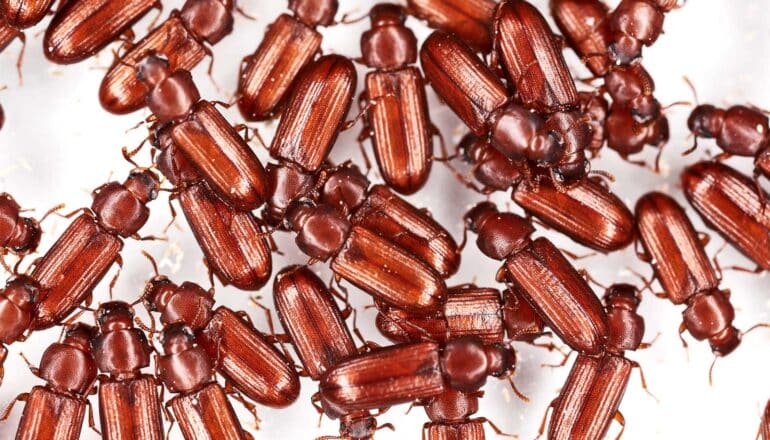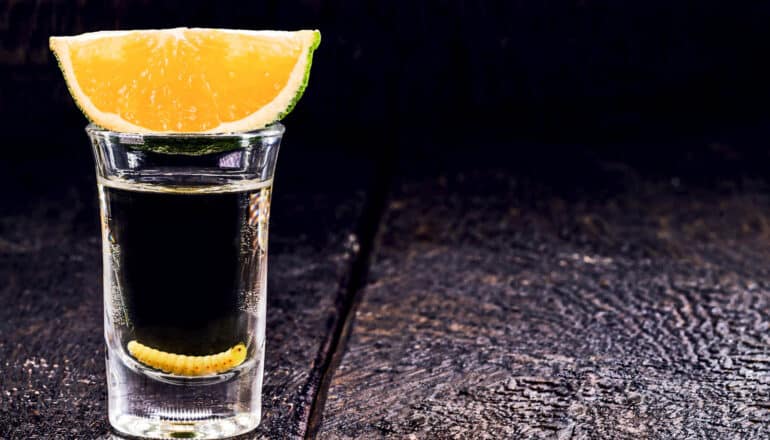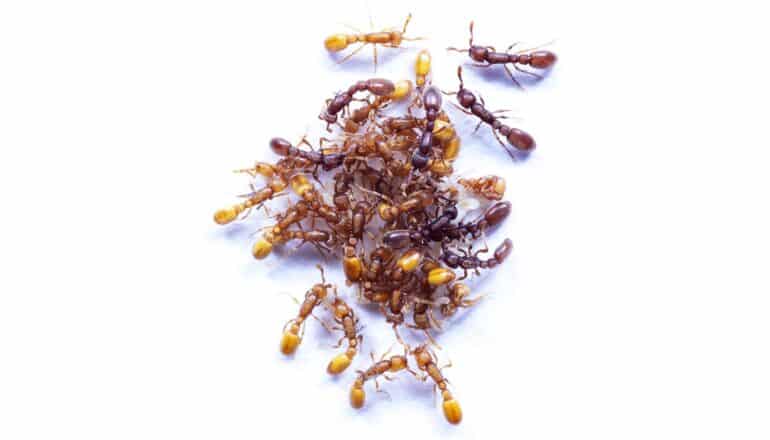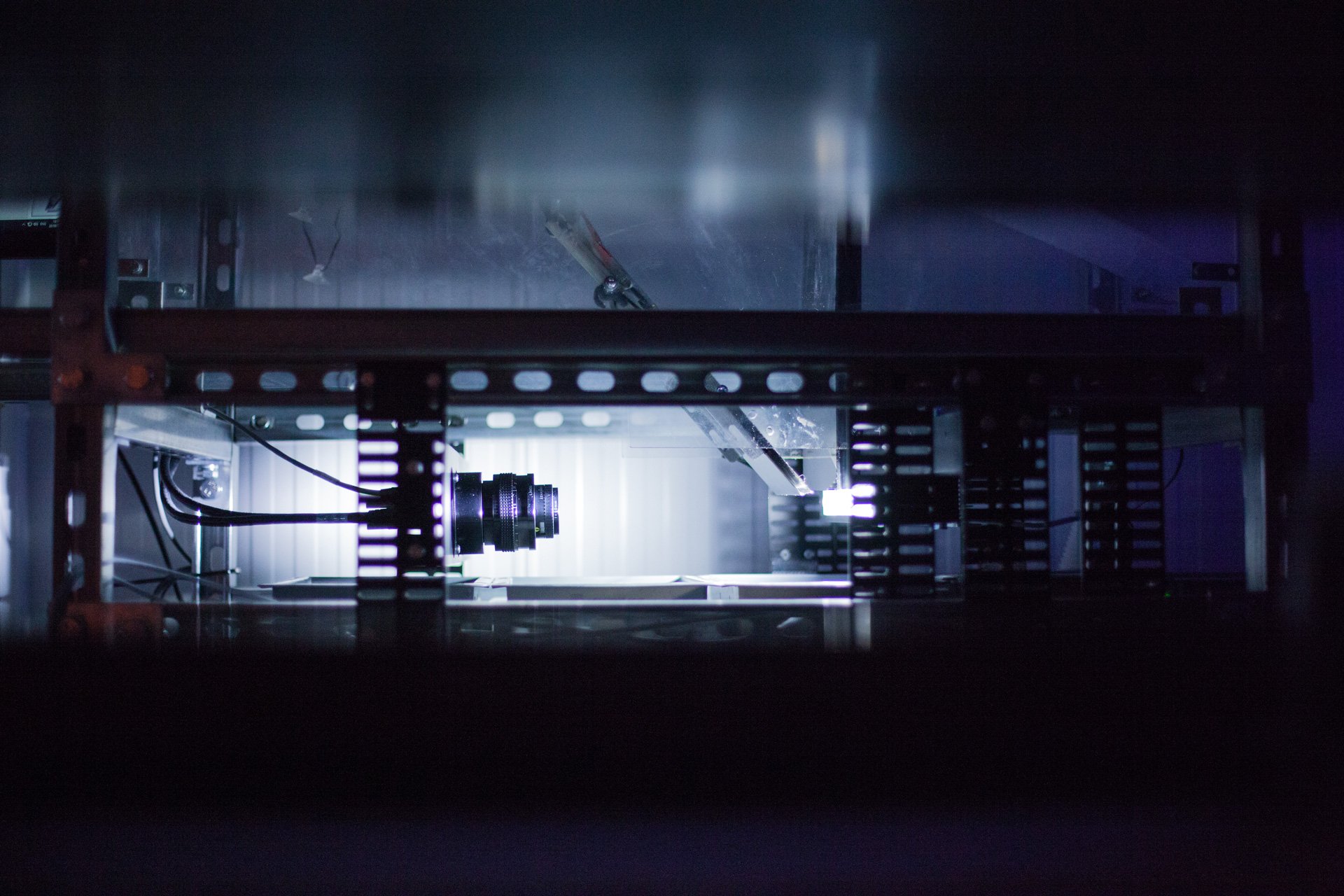
Beetles can survive their entire lives without drinking any liquid water whatsoever. Instead, they suck water from the air with their rear ends.
Insect pests eat their way through thousands of tons of food around the world every year. Food security in developing nations is particularly affected by animal species like the grain weevil and red flour beetle which have specialized in surviving in extremely dry environments, granaries included, for thousands of years.
For a new study in the Proceedings of the National Academy of Sciences, researchers investigated the molecular and physiological processes underlying how beetles stay hydrated.
Indeed, beetles can open their rectums and take up water from moist air and convert it into fluid, which they can then absorb into their bodies. This novel approach to consuming water has been known for more than a century within scientific circles around the world, but never fully clarified until now.
“We have shed new light on the molecular mechanisms that allow beetles to absorb water rectally. Insects are particularly sensitive to changes in their water balance. As such, this knowledge can be used to develop more targeted methods to combat beetle species which destroy our food production, without killing other animals or harming humans and nature,” says lead author Kenneth Veland Halberg, associate professor in the biology department at the University of Copenhagen.
The researchers studied the internal organs of red flour beetles to learn more about their ability to absorb water through the rectum. Red flour beetles are used as so-called model organisms, which means that they are offer tools that make them easy to work with and that their biology is similar to that found in other beetles.
Here, the researchers identified a gene that is expressed 60 times more in the beetle’s rectum compared to the rest of the animal, which is higher than any other gene they found. This led them to a unique group of cells known as leptophragmata cells. Upon closer inspection, they could see that these cells play a crucial role when the beetle absorbs water through its rear end.
“Leptophragmata cells are tiny cells situated like windows between the beetle’s kidneys and the insect circulatory system, or blood. As the beetle’s kidneys encircle its hindgut, the leptophragmata cells function by pumping salts into the kidneys so that they are able to harvest water from moist air through their rectums and from here into their bodies,” Veland Halberg says. “The gene we have discovered is essential to this process, which is new knowledge for us.”
Besides being able to suck water out of the air, beetles are also extremely effective at extracting liquid from food. Even dry grain, which may consist of 1-2% water, can contribute to a beetle’s fluid balance.
“A beetle can go through an entire life cycle without drinking liquid water. This is because of their modified rectum and closely applied kidneys, which together make a multi-organ system that is highly specialized in extracting water from the food that they eat and from the air around them. In fact, it happens so effectively that the stool samples we have examined were completely dry and without any trace of water,” Veland Halberg says.
Over the past 500 million years, beetles have successfully spread across the planet. Today, one in five animal species on Earth is a beetle. Unfortunately, they are also among the pests that have a devastating impact on our food security. The red flour beetle, grain weevil, confused flour beetle, Colorado potato beetle, and other types of beetles make their way into up to 25% of the global food supply every year.
We use approximately $100 billion in pesticides worldwide every year to keep insects out of our food. However, traditional pesticides harm other living organisms and destroy the environment.
Therefore, according to Veland Halberg, it is important to develop more specific and “eco-friendly” insecticides, which only targets insect pests while leaving more beneficial insects, such as bees, alone. This is where a new and better understanding of beetles’ anatomy and physiology could become key.
“Now we understand exactly which genes, cells, and molecules are at play in the beetle when it absorbs water in its rectum. This means that we suddenly have a grip on how to disrupt these very efficient processes by, for example, developing insecticides that target this function and in doing so, kill the beetle,” he says.
“There is twenty times as much insect biomass on Earth than that of humans. They play key roles in most food webs have a huge impact on virtually all ecosystems and on human health. So, we need to understand them better.”
Additional coauthors are from the University of Edinburgh and the University of Copenhagen.
Source: University of Copenhagen
The post How beetles use their butts to suck water from the air appeared first on Futurity.


Scientists have identified the so-called worm at the bottom of some bottles of tequila.
Mezcal is a distilled alcohol made from the boiled and fermented sap of agave plants. Most mezcal beverages—including all brands of tequila—are sold as pure distillates, but a few have an added stowaway bottled inside: worms.
Called gusanos de maguey (Spanish for agave worms), these odd organic chasers aren’t actually worms, but instead a type of insect larva, and their addition to mezcal is a recent one. Mezcal production has a storied history, dating back to the first Spanish inhabitants of Mexico, but larvae were only added to the drink in the 1940s.
Maguey worms have been harvested as a delicacy for centuries, beginning with the Aztecs.
Since then, gusanos have helped boost the popularity of mezcal, but their identity has remained elusive. There’s no consensus on what type of larva is used in mezcal or even if it belongs to one or multiple species. They’ve been variously ascribed to moths, butterflies, and even a type of weevil.
“It’s relatively easy to broadly determine the kind of larva based on the shape of the head, but their identity has never been confirmed,” says Akito Kawahara, curator at the Florida Museum’s McGuire Center for Lepidoptera and Biodiversity. “This is probably because most biologists are not looking inside mezcal bottles.”
In a new study in the journal PeerJ Life & Environment, Kawahara and his colleagues decided to pin down the identity of the mezcal gusanos. In 2022, they traveled to Oaxaca, Mexico, which has been the center of mezcal production for hundreds of years. There, they visited distilleries and obtained as many different brands as they could find to ensure a diverse sampling of larvae.
There were very few distinguishing features that could be used to assign the specimens to a particular group or species; fortunately, mezcal makes an excellent preservative, preventing the decay of the larvae and their internal packets of DNA. The researchers successfully extracted and analyzed genetic material from 18 specimens, but the results they got back were unexpected.
Since gusanos de maguey aren’t commercially farmed, the authors suspected that mezcal worms would likely be sourced from several unrelated species. This included a type of butterfly called the tequila giant skipper (Aegiale hesperiaris), which lays its eggs on agave plants. Their large, milky-white caterpillars parasitize several agave species, boring tunnels through the rigid, succulent leaves. The eponymous common name, combined with their white larvae—which matches the color of many gusanos de maguey—marked them out as a primary suspect.
Instead, the DNA unequivocally identified all 18 specimens as the caterpillars of agave redworm moths (Comadia redtenbacheri), another type of agave parasite with rosy-hued larvae. The researchers suspect that accounts of white gusanos de maguey come from caterpillars that have been stored in alcohol for long amounts of time and have consequently leached their color.
The results add a sobering note to what is currently a boom in the international popularity of mezcal. According to a report by Straits Research, an independent analytical firm, the sale of mezcal is expected to increase by 22% in the next decade, reaching $2.1 billion in profits by 2030, riding a growing wave of interest in artisanal, ethically manufactured products.
Unlike tequila, which is mass-produced in industrial autoclaves, mezcal production continues to rely on small-scale facilities in Mexico’s arid countryside. Farmers roast the barrel-shaped agave cores in open fire pits or specialized kilns, then chop and pulverize the crisp stumps for fermentation and small-batch distribution. It’s unclear whether all mezcal distilleries and landowners will be able to sustainably scale up production to meet demand.
The fate of agave redworm moths is also uncertain. Maguey worms have been harvested as a delicacy for centuries, beginning with the Aztecs. But demand for the larva in Mexican culinary establishments has also seen an increase in recent years, to the extent that wild populations of these caterpillars are considered at risk of over-harvesting.
“Agave worms are still fairly common, but the impact of mezcal becoming popular can have long-term negative effects on local populations because they are harvested in the wild,” Kawahara says.
Red agave caterpillars burrow deep into the core of their hosts plants, and collecting them often kills the agave. For production to scale with the growing market, it’s possible local harvesters may need to actively grow caterpillars on agave farms or find ways to produce them outside of their host plants.
Source: University of Florida
The post Tequila worms are an unexpected larvae appeared first on Futurity.

I had no idea how leafcutter ants did their job, but this "Ant Lab" clip (below) explains it well in just 41 seconds, and the close-up photography is outstanding. The Ant Lab YouTube channel, which has a bunch of great science and insect videos produced by the North Carolina Museum of Natural Sciences, won me over — I just subscribed. — Read the rest

A type of ants called workerless social parasites could help clarify the molecular mechanisms behind caste differentiation, or how an ant develops into a worker or a queen.
Delving into the genetics of these unique ants could also help illuminate the biological processes that drive the development of all animals.
Ants are known as hard workers, tirelessly attending to their assigned tasks—foraging for food, nurturing larvae, digging tunnels, tidying the nest. But workerless social parasite ants are total layabouts.
The rare species exist only as queens, and they die without workers to tend to them. To survive, parasitic ants infiltrate a colony of closely related ants, where, as long as they keep their numbers relatively low, they and their offspring become the leisure class of the colony.
It’s long been thought that these determinedly lazy insects likely evolved their queenly characteristics one by one, through a series of mutations, in an isolated setting.
Now scientists in the Laboratory of Social Evolution and Behavior at Rockefeller University, together with their collaborators at Harvard University, have a new theory.
As they report in Current Biology, they’ve discovered queen-like mutants—parasitic ants that spontaneously appeared in colonies of clonal raider ants, which are typically queenless.
“This mutant is like the precursor to other parasitic species,” says lead author Waring Trible. “It’s a new way of understanding how ants evolve to become socially parasitic.”
Among the more than 15,000 identified ant species are hundreds that qualify as social parasites. Born inside a host colony, a parasitic ant will leave the colony, use a sex pheromone to attract a male from another colony to mate with, and once pregnant, will infiltrate the original colony or find another nearby. She’ll often use subterfuge to sneak past colony guards.
The shampoo ant, for example, will snatch a few ants just outside a nest entrance, lick them to acquire the colony’s signature chemical scent, and then lick herself all over to transfer it to her own body. Chemically cloaked, she then can slip inside to live out her life and reproduce both new queens and males who mate outside the colony. The males die, and the queens begin the cycle again.
Because of their uniqueness, they’ve been studied extensively by biologists since Charles Darwin. Still there’s been a sticking point in a prevailing theory of their evolution, says Daniel Kronauer, associate professor at Rockefeller University, and head of the lab. They’re closely related to their hosts, but if they had to acquire these parasitic traits over time, they would need to be isolated during reproduction, otherwise interbreeding with their hosts would wash out their unique traits. But no one has found intermediately evolved ants—ones with some social parasite traits but not others—in the wild, says Kronauer.
When queen-like ants suddenly appeared among the clonal raider ants in Kronauer’s lab in 2015, Trible—who was looking to investigate genetic mechanisms behind caste differentiation—took notice.
Because clonal raider ants typically have no queens and reproduce asexually, the queen-like mutants stood out: they were born with wings, larger eyes, and ovaries, and as adults showed a general indifference towards labor.
But it turned out they were nothing new—they’d had been hiding for years in dense colonies whose numbers obscured their presence. Genetic analysis revealed that they had mutated into existence inside the colony in which they were first detected—a community of otherwise normal ants that Kronauer had collected in Okinawa, Japan, in 2008, and that still lived in the lab. It was a clue that the typical story of parasite ant invasion might need rethinking.
The researchers then ran a series of experiments and genetic analyses. One of the first experiments was to isolate them to see whether the phenotype was heritable. Because clonal raider ants reproduce asexually, they didn’t have to worry about interbreeding with other ants.
The queen-like mutants lay eggs that developed into copies of themselves. “We knew we had something cool,” Kronauer says.
They also tested behavior. Foraging parties composed entirely of queen-like mutants were half the size of those of worker ants, and they were far less likely to try to enlist other ants to track down food. These behaviors were a sort of intermediary between the diligence of worker ants and the dependence of queens, and allowed the mutant ants to avoid the dangers inherent to leaving the safety of the colony.
Despite laying twice as many eggs as their hosts, the ants self-regulate their head count. As long as their numbers stay below about 25 percent of the host population, they do well. More than that and they run into trouble. Queens need help from workers to free their wings as they emerge from the pupae, and if there are too many queens for the workers to look after, they’ll die entangled in their pupal skin.
“They seem to have the ability to regulate their own reproduction so that they don’t drive their host colony extinct, which is a very smart thing for a parasite to do,” says Trible, a former member of Kronauer’s lab who now runs his own lab at Harvard studying these and other mutants. “This provides these mutants the capacity to survive for long periods of time.”
Whole-genome sequencing revealed that the parasitic queens have a mutation in chromosome 13, which is structurally similar to chromosomes that regulate colony social structure in other ants. This mutant chromosome seems to contain a “supergene,” a set of genes that work together to create a phenotype. In this case, the supergene contains more than 200 individual genes, a disproportionate number of which assist in the metabolism of hormones.
These include genes that code for cytochrome p450 enzymes, which are required to synthesize hormones in both ants and humans, and may play a role in the creation of these highly unusual mutants. (This enzyme family may be familiar to anyone who has been warned to not drink grapefruit juice while taking certain medications because the juice inhibits the enzymes from detoxifying the drugs.)
It appears that with this single mutation, “their form, the higher egg production, the behavior—it can all shift in a single mutational step,” Kronauer says.
And if that’s the case, Trible says, “it would be a way that it’s actually possible to go from a normal ant to a parasite within a single species.”
That idea—that two very different forms of an animal can arise in a single species—gets at the heart of the mystery of ant castes. Because workerless social parasites arise from a very specific type of mutation affecting ant caste development, studying the queen-like mutants has the potential to reveal insights into the still-unknown molecular mechanisms that allow ant larvae to develop distinct caste morphologies. “It provides a very comprehensive framework in which to study their evolution,” says Kronauer.
The findings could also lead to further research on an important process of development known as allometric scaling that happens in all animals, including humans, Trible says. Allometric scaling keeps the tissues of an organism proportional to its body size as it grows.
Its mechanisms are unknown, but understanding them likely has relevance to many aspects of human biology, including disease, says Trible. Perhaps queen-like mutants can provide a new avenue of investigation.
“We don’t have good examples of mutations in fruit flies or mice or human genetic disorders that break allometric scaling in such a dramatic way,” he says. “We think this queen-like mutant will be a powerful tool for understanding caste development, and caste development is in turn an ideal model to investigate these larger questions about how allometric scaling works.”
Source: Joshua Krisch for Rockefeller University
The post Mutant queens are clues to social parasite ants appeared first on Futurity.
Even if insects don’t sound appealing to you, black soldier flies could play an essential role in the food chain in the coming years. In particular, these flies’ larvae can become an important source of proteins for livestock and fish.
That’s why Entocycle is raising another $5 million in a Series A funding round led by Climentum Capital, a European climate-focused VC firm. Lowercarbon Capital and ACE & Company are participating in the round as well.
Teampact Ventures is also investing in Entocycle. This new French VC firm is partnering with current and former athletes to invest in tech companies. In addition to contributing money, those sports professionals help startups with team-building advice and mentorship. In that case, Antoine Dupont, Nikola Karabatic, James Haskell and Antoine Brizard are investing in Entocycle.
While Entocycle has been around since 2016, the team of 21 people will now try and commercialize its products. In particular, with this new injection of cash, Entocycle plans to iterate on its flagship product — the Entocycle Neo.
It’s a hardware module that can be used in insect farms to monitor and collect data on the health and productivity of black soldier flies. The Entocycle Neo uses optical sensors combined with a software solution that analyzes images and accurately measures production.
By automating these processes, Entocycle hopes it can increase productivity in insect farms. Using the company’s modules should lead to higher-feed conversion rates and lower mortality.
Similarly, Entocycle has developed a fly cage with built-in climate control. The idea is that Entocycle can help companies in the food industries get started with black soldier fly larvae so that they can secure their supply of proteins.
And this is key to understanding the appeal behind Entocycle. Switching to insect-based proteins could drive down soybean production and imports, as well as deforestation — indirectly. Larvae are a low-carbon alternative as they can be produced anywhere. Insect farms could also integrate into the waste management cycle as black solider flies gobble down food waste.

Image Credits: Entocycle
Entocycle grabs $5 million for its insect breeding technology by Romain Dillet originally published on TechCrunch